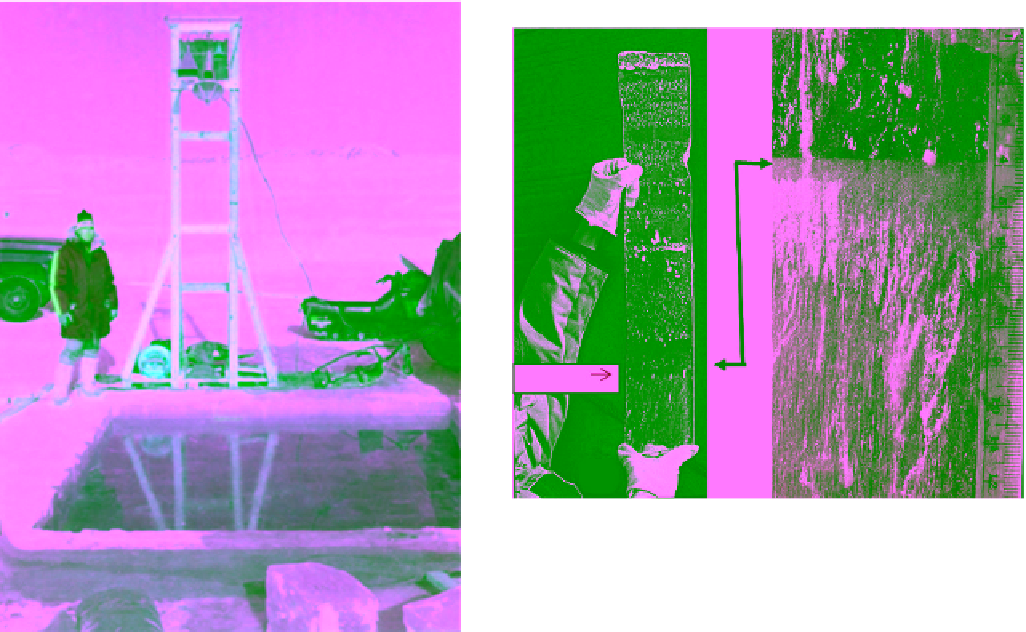Geology Reference
In-Depth Information
(a)
(b)
SY
Ice
FY
Ice
Interface
Figure 5.30
A vertical thick section (100 mm wide and 8 mm
thick) of ice showing (a) the entire depth of the SY sea ice, the
SY‐FY (new ice) interface, and about 120 mm of new ice at
station 9, and (b) details near the interface region (photos by
N. K. Sinha, unpublished).
Figure 5.29
A sled‐mounted antenna was installed for monitoring
microwave backscatter from the surface as the ice formed and
grew in the 3 m × 3 m pond (photo by N. K. Sinha, unpublished).
glass windows, the application of protective coatings on
components of metals and alloys used at high tempera-
tures or corrosive environments or conductive films on
nonmetallic materials for scanning electron micrography.
However, in metallurgy, this has special importance for
polycrystalline materials. The phenomenon can be used
very effectively for forensic type of investigations on poly-
crystalline masses. Differential rate of sublimation across
a boundary between two adjacent crystals or subcrystals
inside the individual crystals leads to the development of
grooved or etched borders along the grain or subgrain
boundaries. This phenomenon is called thermal etching
and provides an extremely powerful, very cheap and ver-
satile tool, especially for relatively pure ice, that glaciolo-
gists have not exploited much. This tool can be used in
the field and the author (N. K. Sinha) has used it exten-
sively for both freshwater and seawater ice.
Figure 5.31 shows thermally etched surface features in a
solid‐state DMT thin section of the ice above and below the
SY‐FY interface. Characteristics of thermally etched hori-
zontal section of the SY has already presented in Figure
5.25. Thin sectioning was performed as soon as possible
after recovery of the ice blocks and etching/photographing
was performed in the field laboratory in Mould Bay. In this
case, the thin section was kept inside the thermal etching
box (see Figure 6.26) and allowed to etch thermally. The
continuity of subgrain boundaries across the interface
is a clear indication that each of the vertically oriented
shows the differences in the optical characteristics of the
two types of ice. The relatively clear, brine‐free SY ice
appears to be dark except for the trapped elongated air
bubbles in it. Note particularly the differences in the char-
acteristics of the scattering of light immediately above
and below the interface. The interface is remarkably
sharp. The new ice immediate below the interface, at a
depth of about 5-10 mm, is very cloudy due to the entrap-
ment of extremely small, but numerous, brine and air
pockets. About 10 mm below the old/new ice interface,
the new growth starts to exhibit some of the macroscopic
features usually noticed in annual sea ice. The top end of
the cloudy zone clearly shows a demarcation line between
the old and the new ice, but it will be seen that there was
continuity in the crystalline characteristics of the two
types of ice across the border.
In Chapter 6 and particularly in section 6.4.3, a very
special aspect of the natural high‐temperature state of ice
will be presented in detail. This property is directly related
to the phenomenon of sublimation or the solid‐to‐vapor
transformation. Sublimation is a common characteristic
of all amorphous or crystalline materials at extremely
high temperatures, close to their melting point. The sub-
limation properties of materials are used for surface
coatings, such as making first‐surface mirrors and tinted

